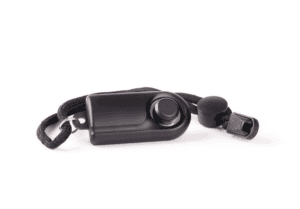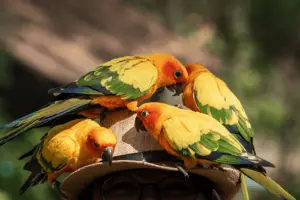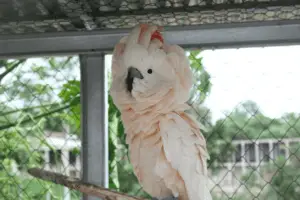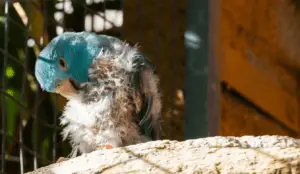Finally, you can introduce clicker training for birds by asking them to continue doing what they love! It can be something as simple as a step up, a handshake, or a high-five. With your reward nearby and a clicker in your hand, you can verbally command your birds. And when your bird does it correctly, you can press the clicker and reward your pet.
Key Steps
- Start by working on your timing with the clicker
- Purchase the suitable treat/reward for your bird
- Get the right clicker and introduce your bird to the clicker
- Teach your bird a new behavior
- Make sure you take a break
- You can start raising the stakes
- You can raise the stakes again
- Start using some cue words
- Reduce the amount of treatment you’re giving it
- Try the above method everywhere
Are you looking for a way to instill positive behavior in your birds while bonding with them? Then you should try clicker training for birds. A clicker is an exceptional training device that can help you condition your bird to associate a clicker sound with rewards.
Therefore, you should start immediately if you adopt your bird after the weaning phase. But do you know how to clicker train a bird? This guide will elaborate more on clicker training for birds and more.
So let’s dive right in.
What Does A Clicker Do?
Generally, clicker training birds is an effective method for training your bird. This method uses science-backed positive reinforcement. Therefore, when your bird hears the clicker sounds, it will get excited since it understands that it’s about to get rewarded.
The clicking sounds mark the required behavior that every pet owner needs to see. It communicates to your pet, “Great job! You will get treats for the right behavior in a few seconds.”
The training phase will be pretty fast, especially with your pet looking forward to daily training sessions. Plus, it will ensure that you communicate with your pet effectively.
Birds develop problems because their lifestyles don’t mimic their natural lives. In nature, they tend to molt, reproduce, and then migrate to start another cycle. Unfortunately, the change in routine in captivity tends to trigger several behavioral issues. But with clicker training, you’ll never have to worry about these destructive behaviors.
What Are Bird Clickers?
Bird clickers are small handheld devices that produce a distinctive clicking noise when pressed. Generally, they’re clicking devices, but you can purchase them with target sticks. The target stick helps you to point to what you need the birds to touch. Some target sticks come attached to the clickers, but some are purchased separately.
Therefore, instead of letting your bird guess what you need it to do, you can show it. So when clicking the clicker, you’re communicating with your pet.
How Does Clicker Training Work With Most Birds, Including Parrots?
Most birds, including parrots, are intelligent creatures that learn fast. Remember, they are used to living in flocks. So they’re always looking for a way to fit in a particular flock. And to help them fit in your small flock, you can clicker train it.
When you press the clicker, and your bird understands, it feels like it has blended perfectly with your flock. Remember, there is no negativity for clicker training.
So your work is to observe and learn all the desired behaviors and click as soon as you spot some and reward them. You can match the behavior with a cue, which can be a word or label for the behavior.
You can also use a hand gesture like sticking your finger parallel to the bird. And with no time you’ll find yourself loving the training sessions in no time.
What Is The Right Age To Start Clicker Training?
The best time to start clicker training is as soon as the weaning stage ends, although it is generally possible to do it at any given age. After weaning, your bird will feel a little independent and ready to start learning a few things. This training is so effective you may even use it after your bird ages.
Therefore, if you want your bird to repeat certain behaviors, you should learn how to reinforce them. This training will help you maintain a positive and healthy relationship between you and your birds.
Clicker Training Supplies
- A bird training stand: a training stand is a unique unit for teaching birds to fly and do tricks. Luckily, many options are available, with most of them made from wood, like the Linshry training stand. But they vary in size, so you must determine which suits your parrot.
- Clicker attached to a target stick.
- Treat dispensing cups or pouches.
- Treats: make sure you have your pet’s favorite treat with you.
10 Steps On How To Clicker Train Your Birds

Depending on your bird’s intelligence and personality, this process can take a very long time or just a few sessions. After all, the faster they associate the clicker noises with a reward, the more eager they’ll be to repeat a behavior.
Fortunately, these steps are not as complicated as one might think. Proper preparation and patience will help you complete it in no time.
Step 1: Start by Working on Your Timing With the Clicker
Before you start training or get the treats, you should work on timing with the clicker. It means pressing the clicker at the right time, which is critical to the success of clicker training.
So it would be best to time your clicks properly, which means training for a few hours. After all, you don’t want to press the clicker when your bird puts its foot down when training it to wave hello. It might lead to miscommunication between you two.
Your bird may think you’re rewarding it for putting its foot down instead of waving hello. Therefore, proper timing with the clickers matters a lot.
Other than timing your clicker, you’ll also have to deliver your treats in time, particularly during the early stages of the training process. It would help if you started by providing the treat after 2 seconds of pressing the clicker. After it has begun associating the clicker with a treat, you can start increasing the wait time.
Therefore, before removing the bird from its cage and starting clicker training, you should first perfect your timing. With clicker timing, you can practice with some simple games.
You can start by watching your favorite game and pressing the clicker whenever the characters say a particular word like “yes” or any other word of choice. Press it as soon as someone says that word, and don’t start the training sessions until you have perfected your clicker timing. You can even incorporate the treat-giving sessions at some point while training.
With an exceptional clicker pressing technique, your bird will learn new tricks quickly. But you must be very careful and patient with your pet; remember, different species learn at different times.
Step 2: Purchase the Right Treat/Reward for Your Bird
After perfecting your clicker timing, the next step is determining the right reward for your pet. Generally, most bird owners assume that the proper reward is usually a treat, but that’s not always true.
Some birds can do great with something as simple as praise, affection, or even toys. Therefore, you must examine your bird and determine what works best for it.
Generally, treats are a crucial part of bird training. It serves as a motivation for your bird to behave in a certain way. They help capture your bird’s attention and help it focus on the behavior you’re training them from.
Keep in mind that some birds have the attention span of a toddler, so treats will help you communicate with your bird perfectly. Therefore you need the proper treatment for the job.
The easiest way to achieve this is to avoid the food your bird typically feeds. You can go for a seed mixture, or some dried fruits, place them in a bowl, and see which treat your bird will go for. If it picks a peanut, then it means that it’s willing to work the most for that treat.
You can repeat the process several times and get at least three treats your bird will love. Your bird can pick what they need every time with the three options. With more options, you’ll have more than enough treats to work with every time.
You can mix things up, but make sure the treats are healthy. After all, a sugary treat can be bad for your pet’s health. So even though it’s training and having fun, your pet’s health should always come first.
Step 3: Get the Right Clicker and Introduce Your Bird to the Clicker
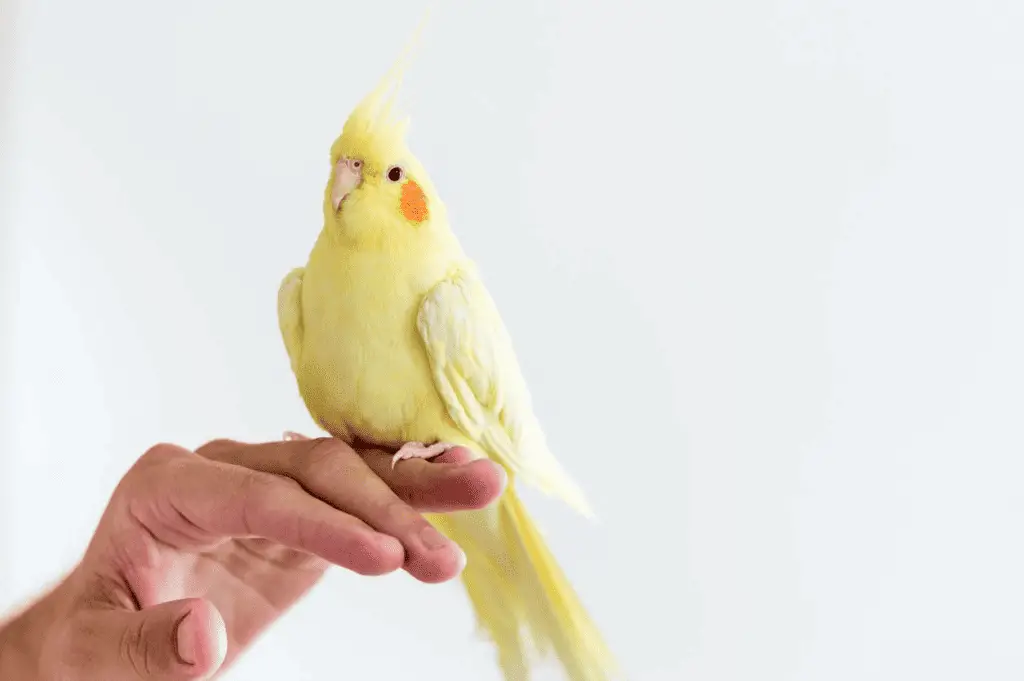
After getting the proper treats, the next step is getting a clicker. So you can go for a clicker with a target stick or one that doesn’t have one. The clicker’s target tick can help you determine what you want the bird to do. If you want it to move from one spot to the next, you can point there, and after it moves, you can reward it.
A great example of a target stick integrated with a clicker is the Trixie target stick. The clicker target stick retracts for a maximum of 65cm and can be helpful when training rabbits, cats, dogs, and birds.
The next step is teaching your bird what a clicker is. This process is mandatory for anyone dealing with a new bird without training. To do that, you should do the following:
- Pour your bird’s favorite treats, then grab your clicker and a T-style bird stand.
- At this stage, you haven’t started the clicker training yet; instead, you’re introducing your bird to the clicker. So you can press the clicker and offer your pet its treat immediately.
- Next, take a break, just like you would while training.
- Once your bird gets distracted and starts focusing on something else, you can press the clicker again. Ensure your bird looks at you while you’re giving it some treats. Once it starts to look at you when expecting a treat, you’ll know you’re making progress. It’s finally associating the clicker with a treat.
- You can repeat the process twice a day for an entire week. But most importantly, you should keep the session short. So you can do it for a few minutes a day.
Step 4: Teach Your Bird a New Behavior
You start the training process with the bird associating your clicker with treats or praises. The clicker has several other advantages, some of which include the following:
- It works perfectly
- All pets, including different types of birds, love it
- You will never have to investigate the cause of the bad behavior before you solve it.
- It’s easy to use
- It’s humane
Remember, any training is a positive way for your pet to receive socialization, intellectual stimulation, and socialization. Therefore, it will gladly learn any positive behavior. So you can teach it a wide range of tricks, including word puzzles, certain sounds, waving, inserting coins in the piggy bank, and even basketball.
Some of the essential behaviors you can teach your bird include:
- How to forage
- Potty training
- Staying put
- Stepping down or up
- Coming to you when you call it
- Willingly exit or enter a carrier or cage
The good thing about clicker training is that it shapes your bird’s behavior without intimidation and punishment. Shaping is a unique force-free method of waiting for your bird to do particular behavior, pressing the clicker, and rewarding it. It means watching your bird; when it does something correctly, you reward it.
But if you want to be in control, you can do the following:
- Start by making the play stand fun and a great place for your bird by introducing water, food, and toys there.
- Next, set the stage by placing the T-stand alone in a specific corner of the counter, ensuring nothing is nearby to distract your pet.
- And then observe your pet and if it perches nicely, plays, or forages, then you can click the clicker and treat it.
- If your bird gets off the stand, then it means that it is not interested. Therefore, you must work harder to keep its attention.
Step 5: Make Sure You Take a Break
Clicker training can be straightforward but can take a very long time depending on how well your bird adapts to the new training. So you need to create a unique strategy and then commit to it. It can be tedious; therefore, you should list the behaviors you want to reward and work on them.
So take a few minutes and relax between the training sessions. A relaxing session can help you rejuvenate and recollect your thoughts, especially if you’re working with a stubborn bird that is not reacting to your cues or the clicker.
Step 6: You Can Start Raising the Stakes
After your pet has started associating certain behaviors with a clicker and treats, you can begin shaping it. It means making it hard for your pet to get rewarded. After establishing the desired behavior, you can start making things harder for your bird. You can do this by making the reinforcement more random.
Instead of rewarding your bird immediately after taking the right direction, you can wait for it to repeat the behavior before rewarding it. You can increase the number of times your bird has to do a certain behavior before pressing the clicker and awarding it.
Intermittent rewards for certain behaviors will make the prize a surprise. Make it seem like winning a jackpot, which means it will do certain things several times before being rewarded, which is an incredibly motivating strategy.
Step 7: You Can Raise the Stakes Again
You can raise the stakes again if you’re rewarding it for being at a particular spot, like on its perch. For instance, you can change the starting point, which means moving your bird further away from the designated location or from the spot it started before.
If your bird moves directly to the perch and stays there by itself, you can reward it. Doing this will force your bird to start functioning independently while monitoring its behavior. You can even move away from it, see if it stays on a perch or designated place for a long time, and then reward it.
You can click the clicker from a distance and reward it if it does. Raising the stakes is like forcing it to behave well in your absence, and makes it a challenge for your bird.
Step 8: Start Using Some Cue Words
Start using some words or phrases to describe certain behaviors; you can use words like “stay” or “spot.” To make your bird understand the word, you can do the following:
- You can take your bird to the starting position and then use certain words like “spot.” If it comes to its spot, then you can reward it.
- Repeat the above procedure a couple of times until your parrot starts moving to its favorite spot as soon as you say “spot.” You can even try it from different areas in the house.
- But you shouldn’t reward it if it goes to the spot before you say the cue. You can repeat this procedure with several commands and ensure your pet understands.
Step 9: Reduce the Amount of Treats You’re Giving To Your Bird
Generally, giving your bird a treat is not practical every time it does certain tricks for you.So what can you do to reduce the amount of treats while still getting the same result? Well, you can create a variable reinforcement schedule. A reliable program can motivate your bird and move to the designated position every time without getting a reward every time.
You can start by rewarding your bird for doing something correctly after four times. Then continue increasing the number of times it has to do something before getting a reward.
Remember, it’s almost impossible for your bird to unlearn anything you teach. But if you don’t use the variable ratio schedule, your pet will return to its old ways as soon as you discontinue the treats.
Step 10: Try the Above Method Everywhere
After your bird gets used to the cue, you can change the circumstances. You can try it when the television is on, or people are around. Make sure it repeats the behavior until it learns.
Conclusion
One of the best methods for reinforcing positive behavior in your bird is clicker training. You can teach the bird to high-five and move to its favorite spot. It is a simple process, and with the right gear and patience, your bird will learn quickly. So ensure you have your clicker, treat, training stand, and dispensing cup.
You can perfect your clicking skills by watching specific videos online to get started. Get the proper and healthy treat that your pet loves. Finally, you can begin observing your bird, and every time it does anything correctly, you can press the clicker and reward.
The continuous reward will force your pet to associate certain behaviors with treats. After perfecting it, you introduce some cues and teach them to obey the words.
- Amazon contributors, Linshry Bird Training Stand, https://www.amazon.com/dp/B07RMZWTR5?tag=misscatfood-20/ Accessed April 29, 2023
- Margaret Root, Behavior, https://pressbooks.umn.edu/vetprevmed/chapter/chapter-9-behavior/ Accessed April 29, 2023
- YouTube contributor, How to use treats in bird training, https://www.youtube.com/watch?v=2xkuv63eEoY/ Accessed April 29, 2023
- Amazon Contributors, Trixie Target Stick, https://www.amazon.com/dp/B00365MU40?tag=misscatfood-20/ Accessed April 29, 2023
- YouTube contributor, How to clicker train your parrot, https://www.youtube.com/watch?v=zCXrlJeubXU/ Accessed April 29, 2023
- Ann Castro, Clicker training, https://www.google.co.ke/books/edition/The_Bird_School_Clicker_Training_for_Par/vyhRz3ndyBkC?hl=en&gbpv=1&dq=A+Guide+To+Clicker+Training+For+Birds&printsec=frontcover/ Accessed April 29, 2023
- Reinforcement schedule, https://pressbooks.online.ucf.edu/lumenpsychology/chapter/reading-reinforcement-schedules/ Accessed April 29, 2023



